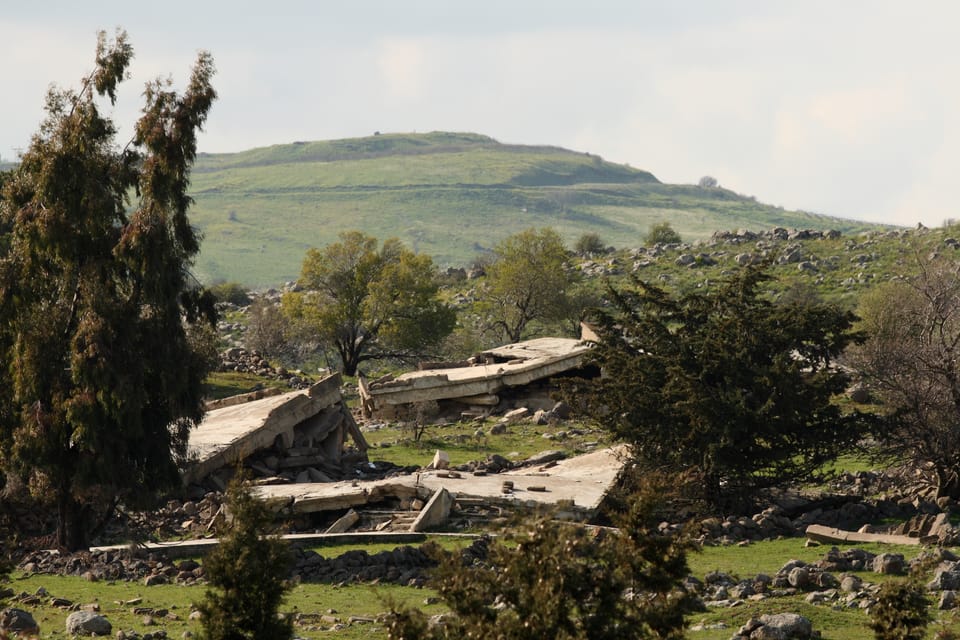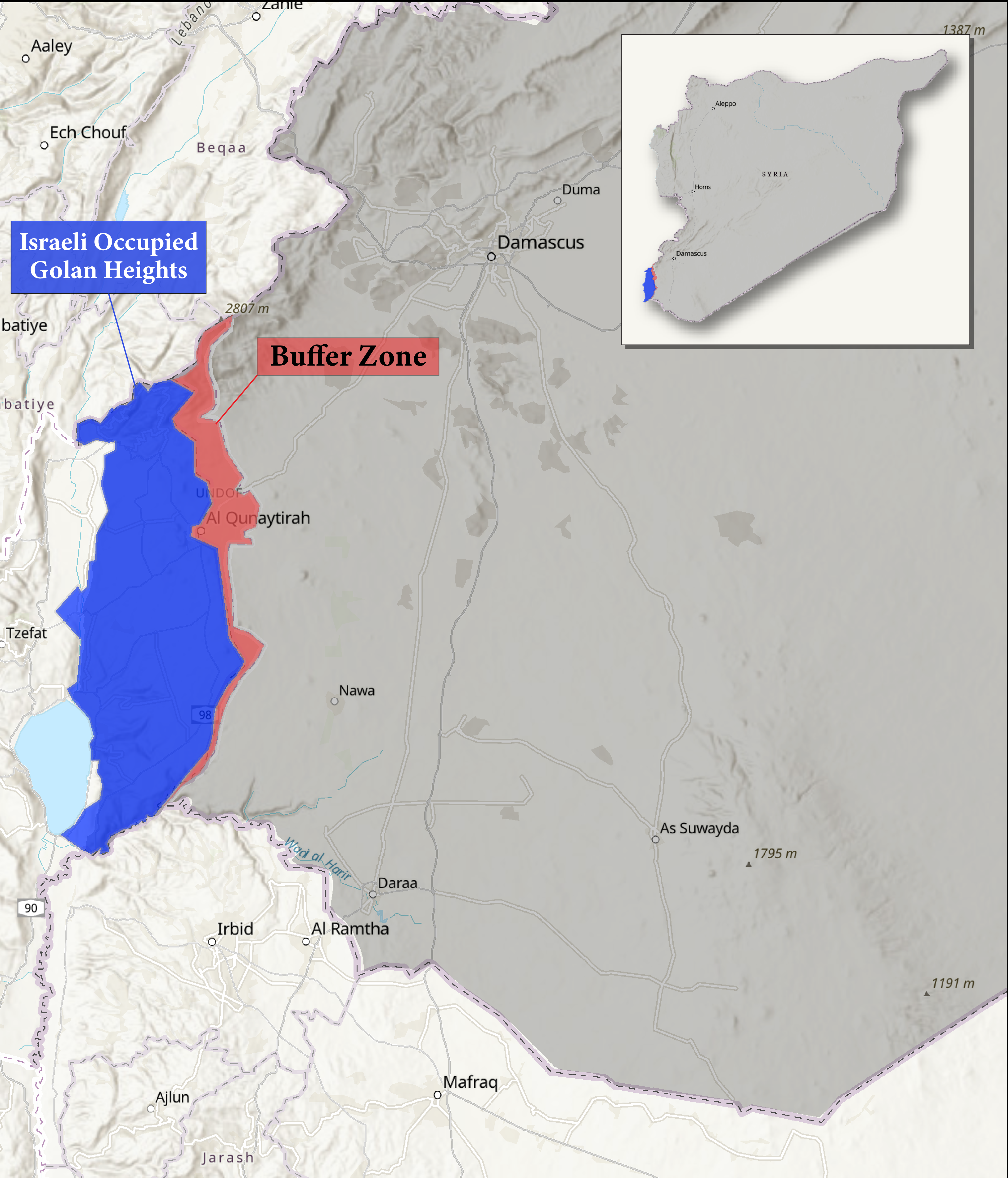
Israel’s Creeping Annexation of the Golan Heights
Since the fall of Bashar al-Assad in December 2024, Syria has continued to face a range of destabilizing actors, including Israel. In addition to the numerous airstrikes Israel has carried out across Syria from December 2024 to May 2025, Israel has also taken steps to expand its occupation in the Golan Heights. Israel seized this highly strategic territory during the 1967 Six-Day War and subsequently established dozens of illegal settlements across it, violating the protections that must be afforded to Syrians living there. Israel’s actions also threaten to draw Syria into a conflict it cannot afford as it seeks to rebuild after over a decade of conflict—delaying peace and justice for the Syrian people.
The Golan Heights is Occupied Land
The Golan Heights is a small area in southwestern Syria approximately 60 kilometers from Damascus that Israel currently occupies in violation of international law. In international humanitarian law, territories are considered occupied when they are placed under the authority of a hostile army. Israel forcibly seized the Syrian territory during the Six-Day war in 1967, in contravention of Article 2(4) of Chapter 1 in the UN Charter, which prohibits member states from using force to undermine the territorial integrity of any state. After the war ended, Israel and Syria established an armistice line, and Israel took control of the Golan Heights—immediately establishing settlements in the area and expelling many Syrians.
Six years after this armistice line was established, Syria attempted and failed to recapture the Golan Heights in 1973 during the Arab-Israeli War. After Syria’s failed attempt, Israel continued to refuse to withdraw completely from the Golan Heights as outlined in U.N Security Council Resolutions 242 (1967) and 338 (1973). In 1974, Syria then signed a disengagement agreement with Israel that stipulated Israel would withdraw from the territories it held in areas beyond the ceasefire lines established in 1967 while also establishing a buffer zone delineated by two disengagement lines. These lines serve as the current de facto border between the two countries.

In December 1981, however, Israel unlawfully annexed the Golan Heights, passing the Golan Heights Law which stipulated that Israel would be “applying law, jurisdiction, and administration” to the territory of the Golan Heights. This violated the Geneva Conventions which require that Syrian law be applied in the occupied territory. In response to this action, every member of the Security Council, including the U.S., voted in favor of UN Resolution 497—declaring Israel’s imposition of its laws in the area as “null and void and without international effect” and demanding that Israel, as the occupying power, rescind its decision to apply the Israeli law to the area. In line with this resolution, Israel’s annexation went unrecognized internationally, until the Trump Administration recognized the territory as Israel’s in March 2019. Despite this recognition, the Golan Heights remains under Israel’s authority and therefore occupied under international law. Concerningly, Israel has recently taken advantage of the tenuous security situation in Syria to expand its occupation of the Golan Heights, even beyond the area recognized by the Trump Administration in 2019 and into the buffer zone.
Creeping Annexation
After the fall of Bashar al-Assad on December 8th, the Israeli government quickly began to implement its long-standing policy of creeping annexation of the Golan Heights, sending Israeli Defense Force (IDF) troops into the demilitarized buffer zone. Israel attempted to justify the move by arguing that its seizure of the buffer zone was defensive and would only last until security along the Syria-Israel border could be guaranteed. Less than a week after troops intervened, however, Israel’s actions pointed to long-term annexation. The government approved an $11 million plan to double the number of settlers in the Golan, which stood at an estimated 31,000 Israeli settlers that were already in the territory alongside 24,000 Druze.
Since then, Prime Minister Benjamin Netanyahu has confirmed that Israel plans to seize the territory permanently, specifically stating that “Israel will continue to hold onto [the Golan], cause it to blossom, and settle in it.” Israel has also established at least six military bases in the demilitarized buffer zone, with Netanyahu claiming that the 1974 agreement that delineated the demilitarized buffer zone is no longer valid because it was an agreement made with the former Assad government. This agreement, however, was made between states and not individuals. As such, the successor Syrian government remains party to the agreement.
Recently, residents of Quneitra, a town in the demilitarized zone of the Golan Heights, have witnessed the IDF carry out home demolitions, detain and arrest civilians, and establish military checkpoints. The Syrian government, for its part, has remained committed to abiding by the 1974 disengagement agreement between the two nations. In an interview , President al-Sharaa commented that peace with Israel is a sensitive and difficult matter, particularly citing the occupation of the Golan Heights as a reason for the nature of the sensitive relationship between the states.
An Unlawful Use of Force
Israel's use of force to expand its presence in the Golan Heights and its claims that it is doing so out of self-defense are both unlawful. As outlined in Article 2(4) of the UN Charter, “All Members shall refrain in their international relations from the threat or use of force against the territorial integrity of political independence of any state, or in any other manner inconsistent with the Purposes of the United Nations.” The prohibition on the use of force allows for very limited exceptions. However, Article 51 of the UN Charter allows for the use of force in the case of self-defense “if an armed attack occurs against a Member of the United Nations.” The response must be necessary and proportional to the initial armed attack.
As the right to self-defense in Article 51 is framed as a reactionary measure to an armed attack, preemptive or anticipatory self-defense is not commonly understood to fall within its scope. However, even if one accepts the controversial view that anticipatory self-defense is lawful, Israel put forward no credible evidence that its expansion into the buffer zone was in response to an imminent attack. In March 2025, Israeli Defense Minister Israel Katz pointed to a general security threat the residents of the Golan Heights faced, explaining that the IDF was prepared to be in Syria indefinitely to “hold the security area in Hermon and make sure that all the security zone in southern Syria is demilitarized and clear of weapons and threats” and “to protect the Golan and Galilee residents against any of [al-Sharaa's] threats and those of his jihadist friends.” Israel’s reliance on self-defense is unlawful: perceived general security threats, not an imminent armed attack, are not enough to trigger its applicability. Moreover, should Israel move forward in its plans to double the amount of the settlers in the Golan Heights and builds settlements in new territory, this furthers suggests that Israel's assertions of self-defense are without a factual basis and that the motivation for these acts is to instead expand Israeli control in the territory.
In addition to the unlawful use of force in the Golan Heights, Israel’s creeping annexation of the Golan Heights itself amounts to an act of aggression that violates the territorial integrity of Syria, one that international law forbids. As scholars have noted, the prohibition on annexation as outlined in the Friendly Relations Declaration should be read as absolute, meaning that annexation itself is unlawful. As such, not only does Israel’s use of force violate international law, but so would its expanding annexation of the Golan Heights.
Israel’s Obligations to Protect Persons in its Occupied Territories
As the occupying power of the Golan Heights, Israel must also afford all civilians the protections recognized by the Fourth Geneva Convention. Israel has violated these obligations in manifold ways. For example, Article 49 of the Fourth Geneva Convention prohibits “individual or mass forcible transfers...from occupied territory” in addition to transferring “parts of its own civilian population into the territory it occupies.” Likewise, Article 53 prohibits Israel from destroying the homes or personal property of the inhabitants. Further provisions require Israel to ensure adequate food and medical supplies, allow for the free exercise of religion, and ensure the proper working of all institutions devoted to the care and education of children.
Currently, Israel is aiming to both increasing the settler population in the Golan Heights while also advancing further into southern Syria. In addition to the government announcing its intentions to double the number of settlers in the occupied territory, residents in Southern Syria reported that Israeli forces had advanced several kilometers into Southern Syria throughout June, destroying homes and razing acres of land. In Quneitra province specifically, soldiers advanced approximately 1.5 kilometers and destroyed 15 homes. While the Israeli army asserted that it was because the homes obstructed the military’s view, residents cited fears the demolitions were a pretext for forcible displacement, which would violate Article 49 of the Fourth Geneva Convention.
Conclusion
Syria stands at a fragile crossroads as it attempts to recover from after decades of conflict. During this tenuous and critical time, Israel’s incursions in the Golan Heights both violate international law and continue to destabilize Syria. If left unchecked by the international community, Israel’s actions in Syria will serve as an obstacle to the Syrian people realizing justice and peace, both of which are long overdue.
___________________________
For more information or to provide feedback, please contact SJAC at [email protected] and follow us on Facebook and Twitter. Subscribe to SJAC’s newsletter for updates on our work